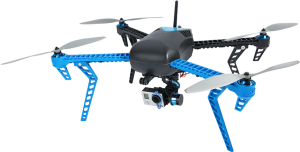CA drone industry rises high
by James Poulos | June 22, 2015 8:43 am
 [1]Thanks to its familiar combination of tech smarts and unorthodox lifestyle, the Golden State has become the epicenter of the drone revolution.
[1]Thanks to its familiar combination of tech smarts and unorthodox lifestyle, the Golden State has become the epicenter of the drone revolution.
According to CB Insights, the Los Angeles Times reported[2], “Northern California is the headquarters of six of the 10 American commercial drone companies that have attracted the most venture capital.” The economic consequences of drones’ ascendance in Silicon Valley have attracted attention along with the cash. Drone firms “are creating high-paying work for engineers, including those designing ever more sophisticated software to operate the machines,” the Times noted.
But, as the Times observed, the Silicon Valley pattern of big innovations in small groups was likely to repeat itself with drones:
“Competition from Chinese manufacturers has already pushed 3D Robotics and some other American drone companies to make their hardware in other countries. Anderson’s company has an engineering center in San Diego, but manufactures its drones in Tijuana and Shenzhen, China, where there is cheap labor.”
Hopes and fears
California’s unique challenges have supplied drone manufacturers with an immediate market and proving ground. Given the state’s vast size, rugged terrain, and drought-era risk of massive fires, drones have emerged as a new source of hope for keeping residents safe. Taking inspiration from their own approach to monitoring outer space for important events, Bay Area astrophysicists have embarked on a project called Fuego — short for “Fire Urgency Estimator in Geosynchronous Orbit.”
“The idea is to enable early location and identification of fires using drones, planes, and satellites mounted with special infrared cameras,” Wired reported[3]; “once fully operational the system could spot new wildfires anywhere in the Western US barely three minutes after they start.
“‘All year round is going to be fire season now,’ says Carlton Pennypacker, an astrophysicist at UC Berkeley and lead researcher on Fuego. ‘That makes this more urgent.'”
But the city of Huntington Beach recently provided the backdrop to a video dramatizing the legal and cultural uncertainty around drones. As the Orange County Register observed[4], the viral clip caught one resident ruining what a local drone company called an instructional video. After “yelling that he’ll be angry if ‘you put that over my house,'” the man sent a hovering drone crashing to the ground with a single swat of his t-shirt. “I don’t even think that’s legal,” he added.
Lucky7drones, makers of the $1,000-plus drone, have filed a police report. In the absence of federal regulation, the Register noted, municipalities have crafted rules restricting or banning drones’ use, while Huntington Beach, among others, has done neither.
Drones’ awkward, changing status in California has aroused residents’ hopes and fears in a complex combination. In Southern California’s beach communities, for instance, drones have begun to emerge as a solution to the age-old threat of shark attacks.
But with the new knowledge they afford has come a new way of sizing up the risks of everyday life.
“A new drone that is being utilized by Southland lifeguards reveals a chilling look at how many sharks are just feet from the shoreline at one beach,” CBS Los Angeles reported[5]. Within minutes of launch, a Seal Beach lifeguard told CBS LA, “we knew there were 10 to 12 sharks all in the Surfside area.” The impact on beachgoers was also swift — calling into question whether Californians’ more carefree attitude toward sharks could survive the advent of drone patrols:
“‘I was planning on going surfing tomorrow and definitely not now,’ one woman said, while another said: ‘Sharks are kind of like my biggest fear so that’s like very daunting for me.'”
Protecting privacy
If Californians have had to give added thought to their new status as watchers, the rise of drones has also forced them to consider how more often they’re willing to be watched. In an effort to shore up the state’s privacy protections against invasive drone use, Assemblyman Bill Quirk, D-Hayward, has pushed a new piece of legislation through several key committees. The bill, AB56[6], “would place strict regulations on law enforcement use of drones, and prohibit drone surveillance of private property without a warrant in most situations,” according[7] to the Tenth Amendment Center.
Under proposed regulations, the Center noted, only so-called exigent circumstances, like natural disasters, public emergencies or the imminent threat of death or grave bodily harm, would permit law enforcement to deploy drones without a warrant or the express permission of property owners.
- [Image]: http://calwatchdog.com/wp-content/uploads/2015/06/Drone.png
- reported: http://www.latimes.com/business/la-fi-drones-20150614-story.html#page=1
- reported: http://www.wired.com/2015/06/fighting-forest-fires-get-big-drones/
- observed: http://www.ocregister.com/articles/drone-664910-flying-beach.html
- reported: http://losangeles.cbslocal.com/2015/06/15/use-of-drone-by-lifeguards-at-local-beach-reveals-chilling-look-at-sharks-near-shoreline/
- AB56: http://www.legislature.ca.gov/cgi-bin/port-postquery?bill_number=ab_56&sess=CUR
- according: http://blog.tenthamendmentcenter.com/2015/05/california-bill-taking-on-warrantless-drone-surveillance-passes-assembly-61-12/
Source URL: https://calwatchdog.com/2015/06/22/ca-drone-industry-rises-high/